Author
Updated
15 May 2019Form Number
LP0734PDF size
8 pages, 756 KBAbstract
The Lenovo ThinkSystem SR950 is a 4U server capable of supporting up to 8 processors and 24 HDDs/SSDs. The SR950 has highlights in areas of performance, memory, modular design, scalability and reliability. This article introduces five key aspects of the new server.
Change History
Changes in the May 15 update:
- Updated for new second-generation Intel Xeon Scalable processors
Video briefing
Introduction
The Lenovo ThinkSystem SR950 is designed for your most demanding, mission-critical workloads, such as in-memory databases, large transactional databases, batch and real-time analytics, ERP, CRM, and virtualized server workloads. Let's take a look at five highlights of the SR950.
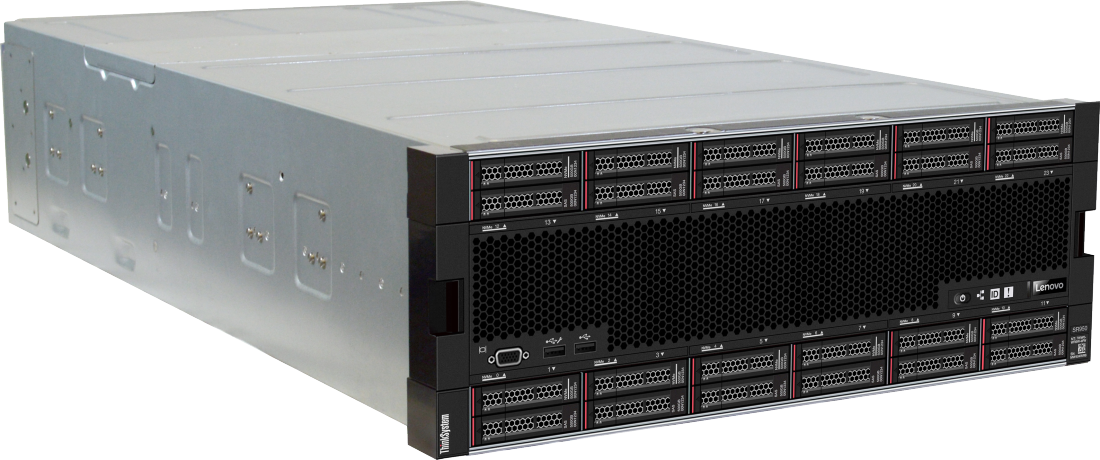
Figure 1. Lenovo ThinkSystem SR950
1. World Record Performance
Faster transaction speeds and accelerated operations mean real-time responsiveness, quick results, and increased productivity. Fast processing allows you to handle today’s unprecedented growth in data volumes and improve the accuracy and precision of workloads requiring high performance.
The SR950 was designed for high performing and demanding workloads. The SR950 supports the highest and fastest second-generation Intel Xeon Scalable processors in 4 socket or 8 socket configuration. The Lenovo ThinkSystem servers currently hold 85 performance world records on the new Intel processors, of which 45 are on the SR950 alone. The SR950 holds far and above more world records than any other competitive server. These world records are in areas such as Business Processing, Big Data Analytics and Infrastructure Virtualization
Read about the 85 new world records held by the ThinkSystem Servers.
2. Highest Memory & Virtualization Capability
A server with In-memory computing allows the processing of tremendous quantities of data in main memory to provide immediate results from analysis and transaction. The data is available for processing or analysis immediately after it is created.
Strong virtualization capabilities create a more dynamic and fluid environment in which compute capacity can be treated as a resource pool, protecting application service levels and improving agility and responsiveness to business needs. Importantly, virtualization isolates workloads so that they do not interfere with one another.
The SR950 supports up to 12TB of memory in a 4 socket configuration and up to 24TB in an 8 socket configuration. This massive amount of memory enables the SR950 to support in memory intensive workloads and implement large virtual machines or run very large in-memory databases without compromise such as SAP HANA.
The SR950 with the new second generation Xeon Scalable Family processors supports 64GB, 128GB, and 256GB DIMMs delivering up to 36% total performance improvement over the first generation processor.
The ThinkSystem SR950 also supports Intel Optane DC Persistent Memory delivering a new, flexible tier of memory designed specifically for data center workloads that offer an unprecedented combination of high-capacity, affordability and persistence. This technology will have a significant impact on real-world data center operations: reduction of restart times from minutes down to seconds, 1.2x virtual machine density, dramatically improved data replication with 14x lower latency and 14x higher IOPS, and greater security for persistent data built into hardware.
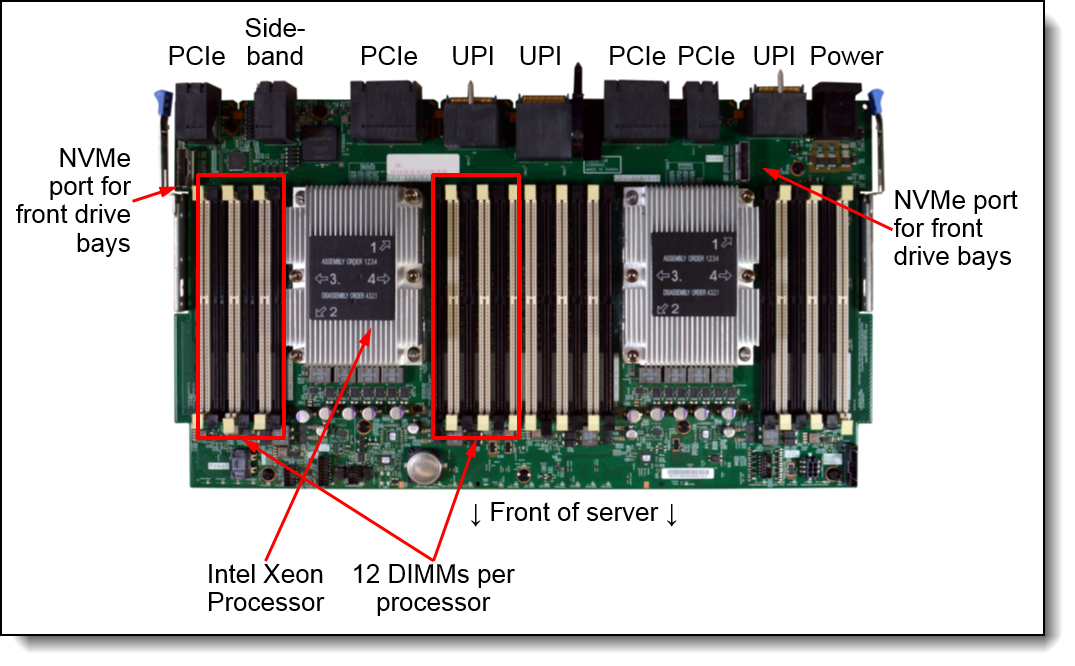
Figure 2. Compute system board
3. Modular Dense Design
A dense server allows more processing and storage capabilities in same amount of data center space. As companies grow, so too do their hardware needs and with them the need for someplace to store all of that hardware. Acquiring new space through expansion of the data center or the creation of new data centers can be expensive, disruptive, and sometimes impossible.
A server with good serviceability allows clients to avoid repeat failures with accurate diagnostics, perform concurrent repairs on higher failure rate items and perform quick and easy repairs or upgrades.
The SR950 provides up to 8 sockets, 96 DIMM slots, 19 slots for LOM, PCIe, RAID and 24 HDD/SSDs all in a dense 4U design commonly found in much larger rack or blade systems. The modular design provides access to all components in the front and rear of the server without pulling out the server. This provides easier and quicker access for maintenance or upgrades.
The modular design allows clients to upgrade from a 2S to 4S and even 8S configuration by adding Compute System modules. The modular design allows for hot-swap fans to be pulled and added via the front of the server without sliding the server out or taking anything off except a small bezel.
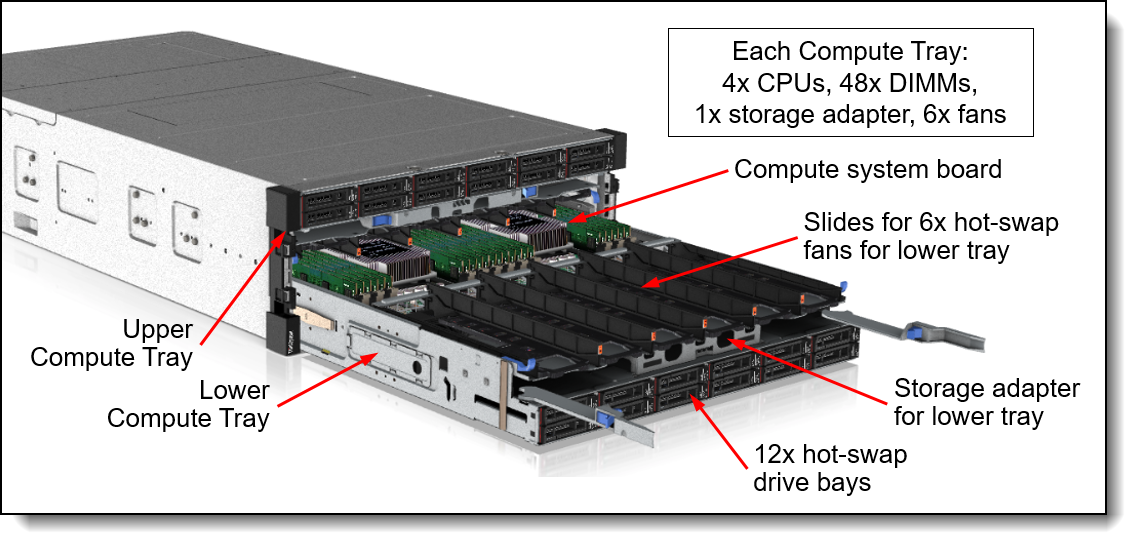
Figure 3. Lower Compute Tray partially removed
4. Scalability to Meet Your Needs
Scalability allows a system to expand to meet increasing performance and sizing workload demands. Scaling memory is how much memory you can add to your server. Processor scaling is how many and the types of processors you can add to your server. Enterprises need assurance that the architecture is designed in such a way that system capacity can be increased as the needs of the business change.
The SR950 provides seamless scalability to meet increasing workload demands and allow you to scale the system to meet your needs. The SR950 supports from 2 processors all the way up to 8 processors including the full range of Intel 4-8S capable second-generation Intel Xeon Scalable Family processors. In terms of storage, the SR950 supports up to 24 HDD/SSD and up to 12 NVMe drives in 4 or 8 socket configurations. For rear I/O, you can add PCIe risers to increase I/O capabilities up to 17 rear facing LOM/adapters. The SR950 supports 1 DIMM per socket or up to up to 12 DIMMs per socket (total 96 in 8S) to match your memory needs.
The SR950 supports five different primary configurations, depending on the desired number of processors, drive bays, PCIe slots and upgradability to an 8-socket configuration. Read about the SR950 Server Configurations.
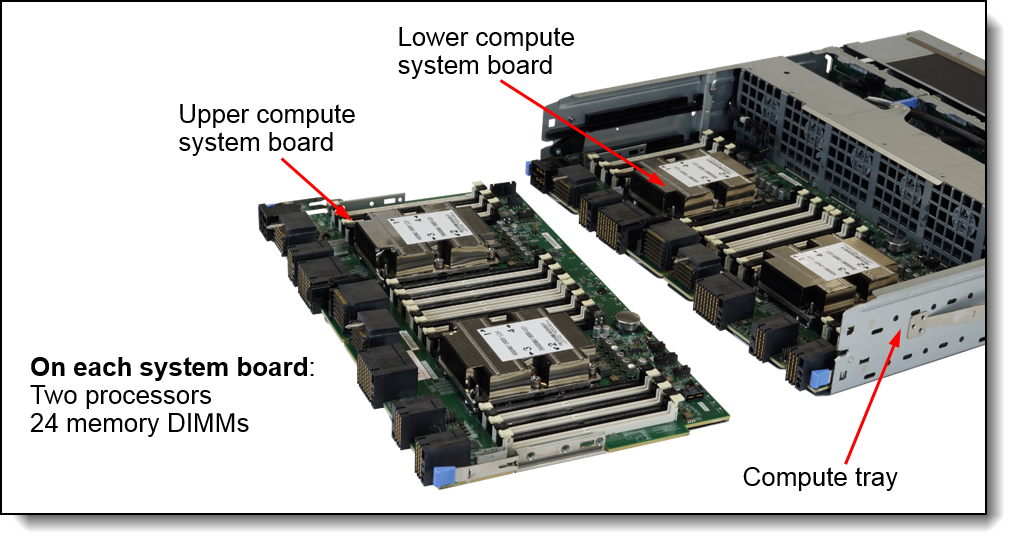
Figure 4. Compute tray with two compute system boards
5. Reliability and Availability for Mission Critical Workloads
Mission-critical workloads support the business in every dimension—its organization, its employees and its customers. These workloads are the most demanding types of applications and databases running on servers today, and include ERP, CRM, data warehouses, business intelligence and analytics. They must be available on a 24 x 7 x 365 basis.
Any outage of the mission-critical server infrastructure results in reduced revenue, reduced profitability, reduced employee productivity, and reduced customer loyalty. Any interruption in the operation or availability of these workloads will have a ripple effect throughout the organization because downtime interferes with business processes and interrupts business continuity. That means that mission-critical workloads must run on highly reliable and available platforms to ensure that business processes are running smoothly.
The SR950 features advanced reliability, availability and serviceability (RAS) features. Including Intel “Run Sure” RAS features and Lenovo unique RAS features. The SR950 provides detection and self-healing of errors as well as the ability of the system to continue processing production workloads, even in the presence of faults. The self-healing technology proactively identifies potential failures and transparently takes necessary corrective actions. Light path diagnostics allows you to diagnose the source of problems in seconds instead of hours or days. Light path diagnostics works hand-in-hand with Predictive Failure Analysis (PFA), which monitors multiple types of system components within the server.
The SR950 drives outstanding system availability and uninterrupted application performance needed to host mission-critical applications. In addition, Lenovo servers continue to be the industry’s #1 most reliable, with the industry’s highest customer satisfaction rating.
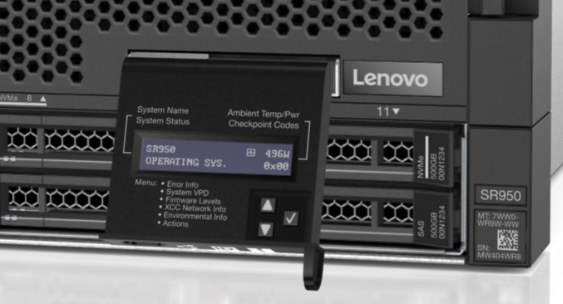
Figure 5. LCD display panel
Further reading
For further reading, see these resources:
This article is one in a series on the ThinkSystem SR950 and SR850 servers:
- Five Highlights of the ThinkSystem SR950
- Five Highlights of the ThinkSystem SR850
- Choosing between Lenovo ThinkSystem SR850 and SR950
- Workloads for 4-Socket and 8-Socket Servers
- Usability in the Design of the ThinkSystem SR950
- The Value of Refreshing Your 4-Socket Servers with the ThinkSystem SR950
- ThinkSystem SR950 Memory Decisions
- ThinkSystem SR950 Server Configurations
- The Value of Refreshing Your 8-Socket Servers with the ThinkSystem SR950
- Lenovo ThinkSystem SR950 New Options and Features - December 2017
- ThinkSystem SR950 Performance Leadership
- Lenovo Servers for Mission Critical Workloads
- Microsoft and Lenovo ThinkSystem SR950 – A Perfect Match
- Accelerate Your 4- and 8-Socket Server Refresh Cycle
- SAP Business Process Applications and Lenovo ThinkSystem SR950 – A Perfect Match
- ThinkSystem SR950 New Options - March 2018
- SAP HANA and Lenovo ThinkSystem SR950 – A Perfect Match
- ThinkSystem SR950 Performance Leadership Continues
- New Solution for SAP HANA - Lenovo ThinkAgile HX
- The Advantages of Keeping Mission Critical Workloads On-Premises vs Going to the Cloud
- SQL Server Migration and Lenovo ThinkSystem SR950
About the author
Randall Lundin is a Senior Product Manager in the Lenovo Infrastructure Solution Group. He is responsible for planning and managing ThinkSystem servers. Randall has also authored and contributed to numerous Lenovo Press publications on ThinkSystem products.
Related product families
Product families related to this document are the following:
Trademarks
Lenovo and the Lenovo logo are trademarks or registered trademarks of Lenovo in the United States, other countries, or both. A current list of Lenovo trademarks is available on the Web at https://www.lenovo.com/us/en/legal/copytrade/.
The following terms are trademarks of Lenovo in the United States, other countries, or both:
Lenovo®
ThinkAgile®
ThinkSystem®
The following terms are trademarks of other companies:
Intel®, Intel Optane™, and Xeon® are trademarks of Intel Corporation or its subsidiaries.
Microsoft® and SQL Server® are trademarks of Microsoft Corporation in the United States, other countries, or both.
Other company, product, or service names may be trademarks or service marks of others.
